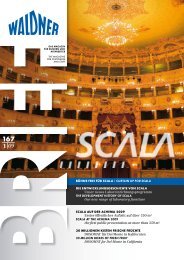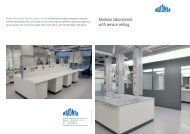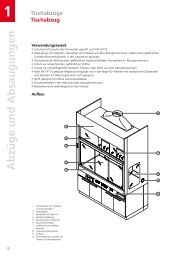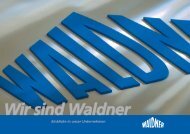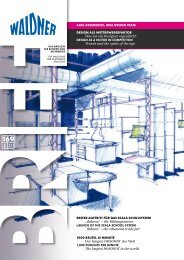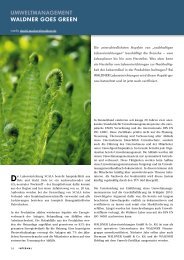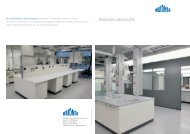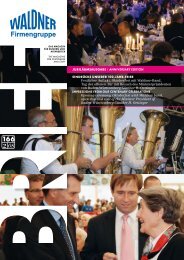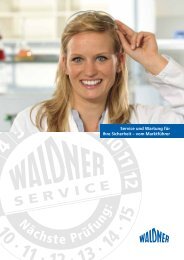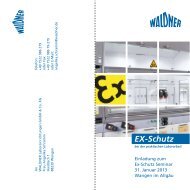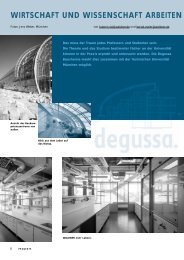Fume cupboards - WALDNER Laboreinrichtungen GmbH & Co. KG
Fume cupboards - WALDNER Laboreinrichtungen GmbH & Co. KG
Fume cupboards - WALDNER Laboreinrichtungen GmbH & Co. KG
You also want an ePaper? Increase the reach of your titles
YUMPU automatically turns print PDFs into web optimized ePapers that Google loves.
<strong>Fume</strong> <strong>cupboards</strong><br />
for high heat and acidic load<br />
With the title DIN EN 14175-7:2012 – <strong>Fume</strong> <strong>cupboards</strong>: <strong>Fume</strong> <strong>cupboards</strong> for high<br />
heat and acidic load (special application fume <strong>cupboards</strong>), the seventh part of<br />
the European series of EN 14175 standards will be issued in June 2012. The new<br />
standard is dealing with fume <strong>cupboards</strong> for special applications, including a high<br />
heat and/or acidic load. These special applications require additional design, safety,<br />
operation and maintenance properties apart from those already stipulated in<br />
the DIN EN 14175-1 to DIN EN 14175-6 standards. Utilization of these special application<br />
fume <strong>cupboards</strong> instead of general purpose fume <strong>cupboards</strong> usually is the<br />
result of a risk assessment. In the following an overview of the standard’s composition<br />
in structure and content and the requirements resulting from the high heat<br />
loads and acidic works to such special application fume <strong>cupboards</strong> will be given.<br />
Excerpt from the foreword of DIN<br />
EN 14175-7<br />
The European standard EN 14175-7 has<br />
been prepared by the technical committee<br />
WG 4 “<strong>Fume</strong> <strong>cupboards</strong>“ within CEN/TC<br />
332 „Laboratory equipment“. The German<br />
mirror committee in charge is the technical<br />
committee “Laboratory fume cupboard“<br />
which is part of the standardization committee<br />
“Laboratory appliances and laboratory<br />
furniture”. It was the leading body<br />
for the preparation of this European standard,<br />
for which the predecessor standard<br />
DIN 12924-2 was used as a template. This<br />
European standard shall obtain the status<br />
of a national standard, either by publishing<br />
an identical text or by acknowledgement<br />
until November 2012. Possibly conflicting<br />
national standards shall be withdrawn until<br />
November 2012. According to the internal<br />
CEN/CENELEC regulations the national<br />
standardization organizations of the following<br />
countries are bound to implement<br />
this European standard: Austria, Belgium,<br />
Bulgaria, Croatia, Cyprus, Czech Republic,<br />
Denmark, Germany, Estonia, Finland,<br />
France, Greece, Hungary, Iceland, Ireland,<br />
Italy, Latvia, Lithuania, Luxembourg, Malta,<br />
Netherlands, Norway, Poland, Portugal, Romania,<br />
Slovakia, Slovenia, Spain, Sweden,<br />
Switzerland, Turkey, and United Kingdom.<br />
Scope of DIN EN 14175-7 and alterations<br />
in comparison with the previous<br />
DIN 12924-2<br />
The DIN EN 14175-7 applies for the following<br />
special application fume <strong>cupboards</strong>:<br />
n <strong>Fume</strong> hoods for high heat loads<br />
n <strong>Fume</strong> hoods for high heat loads in<br />
combination with acidic digestions<br />
n <strong>Fume</strong> hoods for handling of perchloric<br />
acid<br />
n <strong>Fume</strong> hoods for handling of hydrofluoric<br />
acid
It specifies supplementary specifications<br />
and tests for these special application fume<br />
<strong>cupboards</strong> that are relevant to terms, safety<br />
and performance requirements, type test<br />
and onsite test methods as well as their<br />
marking.<br />
In comparison with the predecessor standard<br />
DIN 12924-2 the following essential<br />
alterations have been made:<br />
n Requirements and tests for the four special<br />
application fume cupboard types are<br />
separately structured and formulated<br />
throughout<br />
n Dimensional requirements have been deleted<br />
from the standard<br />
n Admissible materials for the sash have<br />
been limited<br />
n Marking for the purpose of conformity<br />
will be changed with the standard<br />
n Basic requirements for the supplier’s declaration<br />
of conformity have been specified<br />
Basic safety and performance<br />
targets<br />
For all four fume cupboard types dealt<br />
with in the standard the following basic<br />
safety and performance targets apply in<br />
accordance with EN 14175-2 with supplements<br />
such as e.g.:<br />
<strong>Fume</strong> <strong>cupboards</strong> for high heat load and<br />
acidic digestions<br />
n shall guarantee the safety and performance<br />
targets during works with high<br />
heat loads in the fume cupboard interior<br />
n shall prevent hazardous concentrations<br />
and precipitations of acids and caustic<br />
solutions that are released in the interior<br />
and shall withstand the increased requirements<br />
during the planned time of<br />
utilization.<br />
<strong>Fume</strong> <strong>cupboards</strong> for handling of perchloric<br />
acid<br />
Design and execution of the fume cupboard<br />
shall guarantee the avoidance of hazardous<br />
precipitations and hazardous reactions with<br />
the materials used for the fume cupboard<br />
construction during works with perchloric<br />
acid in the fume cupboard interior.<br />
Material requirements<br />
In case of fume <strong>cupboards</strong> for high heat<br />
loads the materials that are used, be it<br />
glass, plastic or other materials, shall be<br />
suitable with regard to their chemical resistance<br />
and heat load capacity for the respective<br />
working temperatures. For works with<br />
heat load or acidic digestions the materials<br />
shall be suitable with regard to the chemical<br />
resistance against acids and acid vapors<br />
and with regard to heat deformation for<br />
the respective working temperatures. Acid<br />
vapors occurring during digestions are extremely<br />
viscid and connect to surfaces they<br />
get in contact with. Materials shall have<br />
even and easy to clean surfaces. If glass is<br />
used as the material for the sash, official<br />
bodies or clients in some European countries<br />
require laminated safety glass as per the<br />
definition given in the EN ISO 1253-1:2011<br />
standard.<br />
In case of fume <strong>cupboards</strong> for handling of<br />
perchloric acid the materials used may not<br />
react with perchloric acid nor may create<br />
neither combustible nor explosive compounds.<br />
The selection of the materials shall<br />
be made with regard to the chemical resistance<br />
and deformation against perchloric<br />
acid at the planned working temperature.<br />
In case of fume <strong>cupboards</strong> for handling<br />
of hydrofluoric acid all parts of the fume<br />
<strong>cupboards</strong> and of the exhaust air ducts that<br />
are in contact with hydrofluoric vapors shall<br />
consist of materials resistant against hydrofluoric<br />
acid. The sash of those fume <strong>cupboards</strong><br />
shall be made of a suitable plastic<br />
material.<br />
<strong>Co</strong>nstructional requirements<br />
Beyond the constructional requirements stipulated<br />
in the EN 14175-2 standard it applies<br />
that material for and execution of the<br />
sash may neither interfere neither with the<br />
operation nor with the safety at the temperatures<br />
in the fume cupboard interior. In<br />
case of fume <strong>cupboards</strong> for acidic digestions<br />
the joints in the fume cupboard interior<br />
shall be limited to the necessary and<br />
sealings shall be durable, impermeable and<br />
permanently elastic. For the work surface<br />
in particular, seamless materials made of<br />
one block should be given preference. The<br />
fume cupboard’s construction shall provide<br />
the required access to clean the worktop<br />
surfaces, the sash and baffle plates as well<br />
as the appliances to avoid, reduce or remove<br />
vapors, in so far as these appliances<br />
are part of the fume cupboard.<br />
In case of fume <strong>cupboards</strong> for handling of<br />
perchloric acid the fume cupboard interior<br />
and the exhaust air zone shall be designed<br />
in such a way that they can be cleaned in<br />
all parts by either spurting out or by scouring<br />
through installed jets. Cleaning requirements<br />
for the part of the exhaust air duct<br />
system that is not part of the fume cupboard<br />
shall be considered. With regard to<br />
the fume cupboard’s execution the collection<br />
of sprinkling liquid from the exhaust air<br />
duct system should be taken into account.<br />
This requirement serves the avoidance of<br />
hazardous precipitation and not for the<br />
cleaning of the exhaust air. If fume <strong>cupboards</strong><br />
for handling of perchloric acid are<br />
equipped with integrated acid fume scrubbers<br />
or with integrated acid exhaust air<br />
sprinklers the design shall allow full access<br />
for cleaning and maintenance purposes.<br />
Airflow and control requirements<br />
Effects on the airflow, caused by heat load<br />
and heating devices as well as by integrated<br />
acid exhaust air scrubbers or integrated<br />
acid exhaust air sprinklers, shall be taken<br />
into account and shall also be limited.<br />
In addition to the fume cupboard function<br />
display with acoustic and visual alarm in accordance<br />
with EN 14175-2 the fume <strong>cupboards</strong><br />
shall be equipped for high heat load<br />
and with a temperature sensor at the fume<br />
cupboard top, which releases an alarm as<br />
soon as the exhaust air’s maximum temperature<br />
defined in the user manual is exceeded.<br />
It should be possible to redirect this<br />
alarm.<br />
Testing of fume <strong>cupboards</strong> with<br />
high heat load<br />
The type test shall be executed in accordance<br />
with EN 14175-3 and on-site tests<br />
shall be executed in accordance with EN<br />
14175-4 with the following supplements: Unter der Annahm<br />
During the tests two heating plates Unter shall Unter be der der Annahm<br />
kW für einen Annahm Abzu<br />
located in the fume cupboard interior. kW <strong>Co</strong>ntainment<br />
behavior and robustness shall be<br />
kW für für einen einen Abzu<br />
tested without heat load (with switchedoff<br />
heating plates) and with a heat load of<br />
4 kW per meter of the fume cupboard’s inside<br />
width each.<br />
Arrangement of heating plates and test gas<br />
outlets in accordance with EN 14175-7<br />
Nach dieser Berec<br />
Nach Nach dieser dieser Berec<br />
knapp 30°C anstei<br />
knapp knapp 30°C 30°C ansteig<br />
zug durchströmen<br />
zug zug durchströmend<br />
vom Material des<br />
vom vom Material Material des<br />
abgegeben wird. des T<br />
abgegeben abgegeben wird. wird. T<br />
dem, dass sich, auf<br />
dem, dem, dass dass sich, sich, auf<br />
innenraums im Str au<br />
innenraums innenraums im im Stra<br />
Innenseite des Fron<br />
Innenseite Innenseite des des Fron<br />
Die Hersteller von<br />
Die Die Hersteller Hersteller von<br />
Auswahl der verw<br />
Auswahl Auswahl der der verw<br />
anderen auch weit verw<br />
anderen anderen auch auch weit<br />
len, Rechnung trag wei<br />
len, len, Rechnung Rechnung trag<br />
Die Einflüsse hohe<br />
Die Die Einflüsse Einflüsse hohe<br />
z. B. mit den Mitte<br />
z. z. B. B. mit mit den den Mittel Mitte
Declaration of conformity<br />
A declaration of conformity shall clearly<br />
state the special field of application of the<br />
respective special application fume cupboard,<br />
together with the planned temperature<br />
range, and shall also confirm that the<br />
materials and the execution of the fume<br />
cupboard are suitable for the special application.<br />
Implementation of the standard’s<br />
requirements into practical work<br />
To implement the requirements of the DIN<br />
EN 14175-7 standard into practical work,<br />
particularly with regard to the effects of the<br />
high heat load, theoretical preliminary considerations<br />
and experimental examinations<br />
are very useful.<br />
The heat flow supplied through the heat<br />
capacity leads to an increase of temperature<br />
∆ T in the fume cupboard interior that<br />
can be calculated as per the following:<br />
· · <br />
<br />
· · ·<br />
· <br />
·· · <br />
Q= m∙QQ ∙ ∆T <br />
<br />
·· ·· ·<br />
· <br />
<br />
Q= V∙ρ∙QQ ∙ ∆T <br />
<br />
∆T= QV∙ρ∙QQ<br />
<br />
··<br />
<br />
<br />
<br />
·· ·· <br />
According to this calculation the temperature<br />
of the air intake in the fume cupboard<br />
would increase for almost 30° C. Measurements<br />
during the experiment show that the<br />
heating of the air that is flowing through<br />
the fume cupboard is slightly lower in reality,<br />
because part of the heat energy is absorbed<br />
by the fume cupboard casing’s material<br />
and released to the outside through<br />
its surface. Temperature measurement at<br />
different locations in the fume cupboard<br />
furthermore show that due to the heat radiation<br />
of the heating plates the surfaces<br />
of the fume cupboard interior in the radiation<br />
area, e.g. on the fume cupboard rear<br />
wall, will be heated up to a temperature of<br />
95° C, or on the inside of the sash up to a<br />
temperature of 65° C.<br />
Therefore the manufacturers of fume <strong>cupboards</strong><br />
for high heat loads shall take care<br />
of a sufficient temperature resistance when<br />
selecting the materials to be used. Furthermore<br />
they also have to take into account<br />
more extensive effects such as e.g. a strong<br />
heating of control units.<br />
The influences of high heat loads to the<br />
flow mechanics of the fume cupboard can<br />
be clearly illustrated by means of e.g. a numerical<br />
flow simulation (CFD).<br />
On the assumption of an exhaust airflow of<br />
By directly comparing “cold“ and “hot“ the<br />
e eines Abluftvolumenstroms 600 m³/h and a heat capacity von 600 of m³/h 6 kW und for einer a Heizleistung von 6<br />
computer simulation shows that the flow<br />
me e eines eines Abluftvolumenstroms fume Abluftvolumenstroms cupboard with a von von width 600 600 of m³/h m³/h 1500 und und mm einer einer Heizleistung Heizleistung von von 6<br />
ug mit einer Breite von 1500mm ergibt sich:<br />
6<br />
velocities in the fume cupboard are heavily<br />
influenced by the heat energy released<br />
ug g mit mit einer einer the Breite following Breite von von 1500mm result 1500mm is obtained: ergibt ergibt sich: sich:<br />
from the heating plates. The changes of the<br />
∆T= 6000 QQ600 Q³h∙1,2<br />
6000 <br />
6000 QQQ3∙1005 QQQ ∙K<br />
6000 <br />
<br />
flow velocities are inevitably accompanied<br />
<br />
<br />
<br />
600 <br />
by a clear change of the complete flow<br />
∆T= 29,85600 600 Q<br />
· 1,2 <br />
· <br />
· 1,2 1,2 · · · 1005<br />
1005<br />
<br />
1005<br />
<br />
·<br />
pattern in the fume cupboard. Thereof the<br />
·<br />
·<br />
obvious assumption can be deduced that<br />
2,5 <br />
the containment of a fume cupboard in<br />
2,5 2,5 <br />
chnung würde die Temperatur der einströmenden Luft im Abzug um<br />
echnung würde würde die die Temperatur Temperatur der der einströmenden einströmenden Luft Luft im im Abzug Abzug um<br />
igen. Messungen im Experiment zeigen, dass die Erwärmung der den Abden<br />
Luft in der Realität etwas geringer ist, da ein Teil der Wärmeenergie Ab‐<br />
um<br />
igen. igen. Messungen Messungen im im Experiment Experiment zeigen, zeigen, dass dass die die Erwärmung Erwärmung der der den den Abnden<br />
Luft Luft in in der der Realität Realität etwas etwas geringer geringer ist, ist, da da ein ein Teil Teil der der Wärmeenergie<br />
Abzugsgehäuses aufgenommen und über seine Oberfläche Wärmeenergie<br />
nach außen<br />
s Abzugsgehäuses Abzugsgehäuses aufgenommen aufgenommen und und über über seine seine Oberfläche Oberfläche nach nach außen<br />
Temperaturmessungen an verschiedenen Stellen im Abzug zeigen außerfgrund<br />
der Wärmestrahlung der Heizplatten, die Oberflächen des Abzugs‐<br />
außer‐<br />
außen<br />
Temperaturmessungen an an verschiedenen verschiedenen Stellen Stellen im im Abzug Abzug zeigen zeigen außerufgrund<br />
der der Wärmestrahlung Wärmestrahlung der der Heizplatten, Heizplatten, die die Oberflächen Oberflächen des des Abzugsrahlungsbereich,<br />
z. B. an der Abzugsrückwand auf bis zu 95° C oder Abzugstrahlungsbereich,<br />
z. z. B. B. an an der der Abzugsrückwand Abzugsrückwand auf auf bis bis zu zu 95° 95° C oder oder an an der<br />
an der<br />
ntschiebers auf bis zu 65° C erwärmen.<br />
der<br />
ontschiebers auf auf bis bis zu zu 65° 65° C erwärmen.<br />
n Abzügen für hohe thermische erwärmen. Lasten müssen also zum einen bei der<br />
n n Abzügen Abzügen für für hohe hohe thermische thermische Lasten Lasten müssen müssen also also zum zum einen einen bei bei der<br />
endeten Werkstoffe auf genügend Temperaturfestigkeit achten und zum der<br />
wendeten Werkstoffe Werkstoffe auf auf genügend genügend Temperaturfestigkeit Temperaturfestigkeit achten achten und und zum<br />
terreichenden Effekten, wie z. B. einer starken Erwärmung von Bedienteigen.<br />
Bedientei‐<br />
zum<br />
terreichenden iterreichenden Effekten, Effekten, wie wie z. z. B. B. einer einer starken starken Erwärmung Erwärmung von von Bedienteigen.<br />
er thermischer Lasten auf die Strömungsmechanik des Abzugs lassen sich<br />
er er thermischer thermischer Lasten Lasten auf auf die die Strömungsmechanik Strömungsmechanik des des Abzugs Abzugs lassen lassen sich<br />
ln der numerischen Strömungssimulation (CFD) anschaulich darstellen. sich<br />
eln der der numerischen numerischen Strömungssimulation Strömungssimulation (CFD) (CFD) anschaulich anschaulich darstellen. darstellen.<br />
accordance with EN 14175-2 which considerably<br />
depends on the routing of the<br />
flow and the distribution of the extraction<br />
in the fume cupboard interior, and which<br />
had been aerodynamically optimized under<br />
isothermal conditions, is influenced by<br />
the source of heat. <strong>Co</strong>ntainment measurements<br />
with switched-on heating plates<br />
are confirming this thesis. They show that<br />
no satisfying containment can be achieved<br />
with the common exhaust air flows of a<br />
general purpose fume cupboard in accordance<br />
with EN 14175-2.<br />
<strong>Co</strong>ntinuing measurements reveal that solely<br />
by increasing the exhaust air flow to<br />
about twice the normal values – which<br />
also corresponds to a duplication of the<br />
fume cupboard’s energy demand – does<br />
not represent a sufficient measure to safely<br />
operate the fume cupboard with high heat<br />
load by meeting all operating conditions<br />
stipulated in the standard.<br />
During experimental examinations it can<br />
be shown in a first step by means of e.g.<br />
a flow visualization with smoke, that by assimilating<br />
the interior room geometry and<br />
the distribution of the extraction, the fume<br />
cupboard’s exhaust air flow required for a<br />
safe operation under high heat load does<br />
not have to be duplicated in comparison<br />
with a general purpose fume cupboard.<br />
However, it will quickly become clear that<br />
an optimization of the flow routing “hot“<br />
the fume cupboard containment “cold“<br />
will be disturbed and vice versa. To solve<br />
such target conflicts and to find the utmost<br />
balance between energy demand and safety<br />
further aerodynamic examinations and<br />
the respective development works are required.<br />
Velocity vectors in the fume hood interior, with and without source of heat
heating plates on<br />
heating plates off<br />
Testing device for the robustness test<br />
Robustness of containment, with and without heating plates<br />
Summary<br />
While the previous series of EN 14175 standards<br />
exclusively described isothermal conditions<br />
in the fume cupboard, the newly<br />
issued part 7 offers the option to assess the<br />
safety of fume <strong>cupboards</strong> at high heat load.<br />
This closes an essential gap, as works with<br />
sources of heat in a fume cupboard are part<br />
of the daily routine in many laboratories.<br />
Now it is not least up to the manufacturers<br />
to translate the non-trivial requirements of<br />
the standard into innovative solutions and<br />
to also contribute to the safety and power<br />
efficiency for the operation of special application<br />
fume <strong>cupboards</strong> in laboratories.<br />
Visualization of flow, left: heating plates switched off, right: heating plates switched on<br />
<strong>WALDNER</strong> <strong>Laboreinrichtungen</strong> <strong>GmbH</strong> & <strong>Co</strong>. <strong>KG</strong> I Haidösch 1 I D-88239 Wangen im Allgäu<br />
Phone +49 7522/986-0 I Fax +49 7522/986-280 I www.waldner-lab.com



